The Carolina Reaper Pepper, also known as the “hottest pepper in the world”, is not for the faint of heart. This fiery chili belongs to the Capsicum chinense plant family and packs a powerful punch. Its distinctive red skin and bumpy texture make it hard to mistake a Carolina Reaper for anything else.
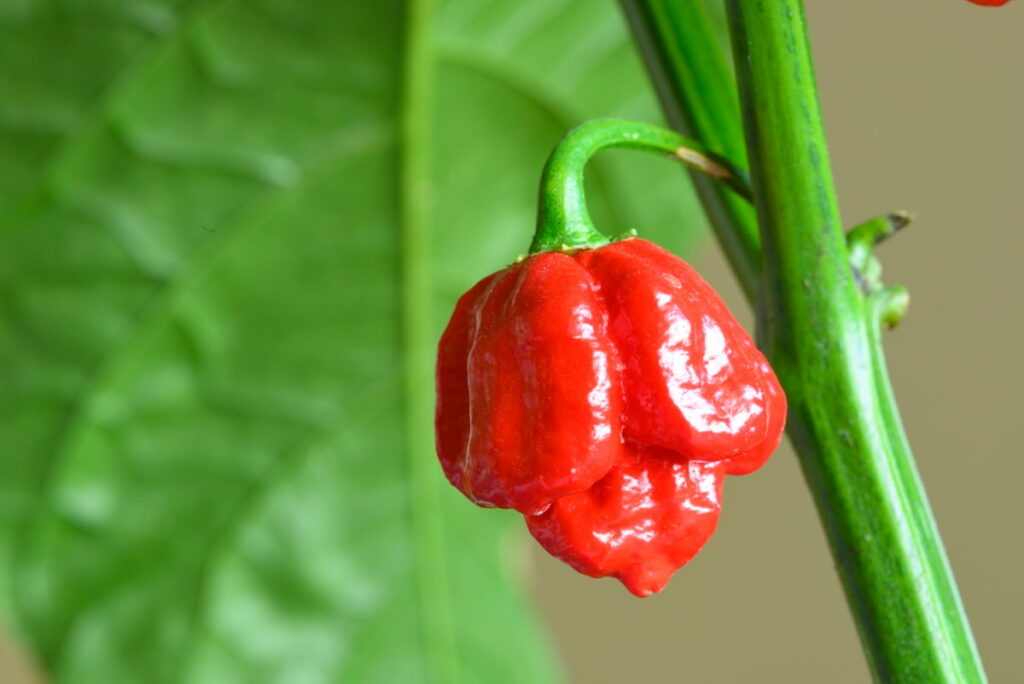
The Carolina Reaper demands optimal growing conditions, including plenty of sunlight, well-draining soil enriched with organic matter, and regular watering without overdoing it. How many Carolina Reapers grow on one plant? Regarding yield per plant, the Carolina Reaper will produce between 20-30 chilies at any time.
Regular picking encourages the ripening of immature fruits while allowing new ones to take their place on each healthy plant. Is Carolina Reaper the hottest pepper? The Carolina Reaper holds the prestigious title of being officially recognized as the World’s Hottest Pepper by none other than the Guinness Book of World Records.
Information About Carolina Reaper Pepper
| Name | Carolina Reaper Pepper |
| Full Sun | At Least 6 Hours of Direct Sunlight |
| Mature Height | 18 – 24 Inches |
| Spacing | 10 – 12 Inches |
| USDA Hardiness Zones | 9 – 12 |
| Growing Temperature | Daytime temperatures – 21-32°C and nighttime temperatures not below 15°C |
| Plant Type | Edible Plants |
| Harvesting Time | 90 days after transplanting |
History and Origin of the Carolina Reaper Pepper
The Carolina Reaper Pepper has a fascinating history and origin, adding to its fiery reputation. Developed by Ed Currie, the owner of the PuckerButt Pepper Company in South Carolina, this pepper took the world by storm when it was crowned the hottest pepper by Guinness World Records in 2013.
The name “Carolina Reaper” perfectly captures the intense nature of this chili. With its origins firmly rooted in South Carolina, this pepper embodies Southern charm and scorching heat. Since its introduction, the Carolina Reaper has gained a cult-like following among spice enthusiasts who always seek new ways to test their taste buds’ limits. Its popularity continues to grow as more people dare to experience its fiery flavor firsthand.
Characteristics and Appearance of the Carolina Reaper Pepper
Its vibrant red color and uniquely wrinkled texture stand out among other chili peppers. The shape of the Carolina Reaper is typically elongated, resembling that of a small bell pepper or habanero. This tail gives it an extra kick in both heat and aesthetics. Not only does the Carolina Reaper deliver on heat, but it also has a unique flavor profile. Despite being incredibly spicy, hints of sweetness and fruitiness add complexity to its taste.
In case you missed it: How to Grow Jalapeno Peppers from Seed: A Step-by-Step Guide for Types, Seed Germination, and Planting
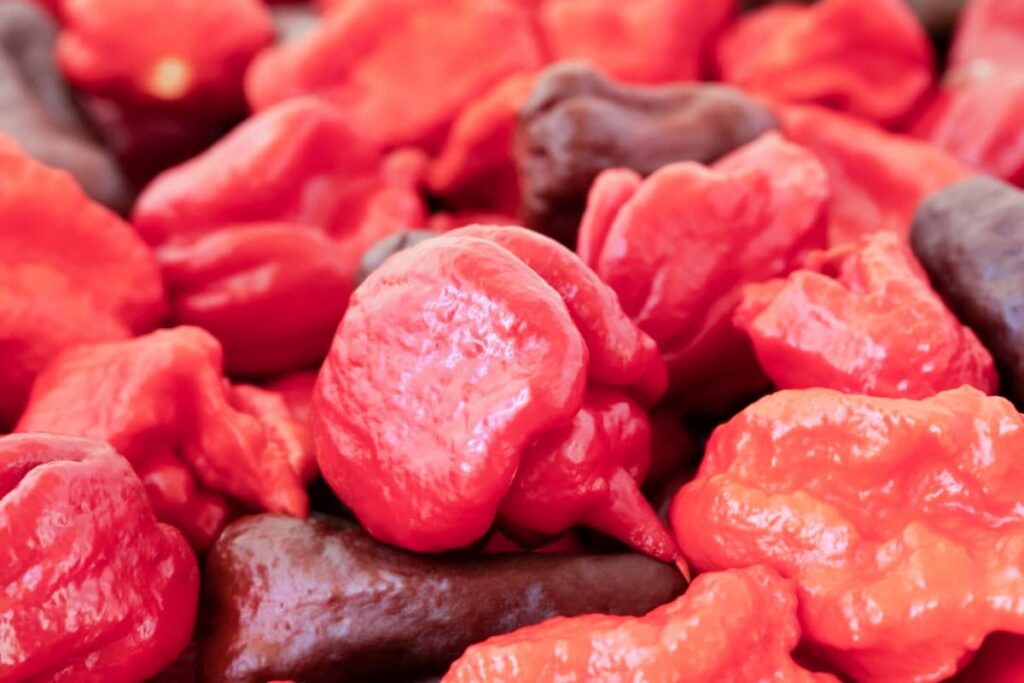
Carolina Reaper Scoville: Scoville Heat Units (SHU)
The Carolina Reaper reigns supreme with its mind-blowing Scoville Heat Units (SHU) when measuring chili peppers’ heat. The Carolina Reaper on the Scoville scale can reach a staggering 1.5 million to 2.2 million SHU. To put that into perspective, a jalapeno typically falls between 2,500 and 8,000 SHU. The intense heat of Carolina Reaper peppers is not for the faint-hearted or those with sensitive taste buds. Even a tiny nibble can send your mouth into an inferno of pain and pleasure at the same time.
Health Benefits and Nutritional Value of the Carolina Reaper Pepper
This scorching chili also offers a range of health benefits and packs a nutritional punch. The Carolina Reaper is packed with vitamins and minerals. It is rich in vitamin A, which promotes good immune function. It contains significant amounts of vitamin C, an antioxidant that supports the immune system.
Furthermore, this pepper is believed to have numerous health properties due to its capsaicin content. Capsaicin has been shown to have anti-inflammatory effects and may help reduce pain associated with conditions. Some research indicates that consuming spicy foods like the Carolina Reaper may offer cardiovascular benefits such as lowering blood pressure levels and improving blood circulation.
Planting Carolina Reaper Pepper Seeds: Step-By-Step Guide
Firstly, make sure you have good quality Carolina Reaper seeds. These can be purchased from reputable seed suppliers or even harvested from ripe peppers (remember that it may take longer for these seeds to sprout). Next, prepare your planting Carolina Reaper seeds in pots or trays with well-draining soil. The ideal pH level for Carolina Reapers is between 5.8 and 6.8, so make sure your soil is within this range.
Now it’s time to plant the Carolina Reaper seeds. Place one seed into each pot or cell and cover them with soil. Don’t bury them too deep, as they need light to germinate. Keep the soil consistently moist, and use a spray bottle to mist the surface if needed. Carolina reaper seeds sprout in 7-10 days, but don’t fret if it takes longer – every seed differs depending on age and environmental conditions. Once the seedlings have emerged, please provide sunlight or artificial grow lights for at least
12 hours daily. Maintain a temperature range of growing Carolina Reaper seeds around 21-29°C for optimal growth. When transplanting your young plants outdoors, space them about 10-12 inches apart to allow enough room for their sprawling branches and abundant fruit production. Remember that growing Carolina Reapers requires patience and attention to detail. Carolina reaper seeds must sprout in 7-10 days but may take longer, depending on the seed’s age and environmental conditions.
In case you missed it: How to Grow Green Chilli Peppers Faster: Best Tips to Increase Flowering, Fruiting, and Production Yield
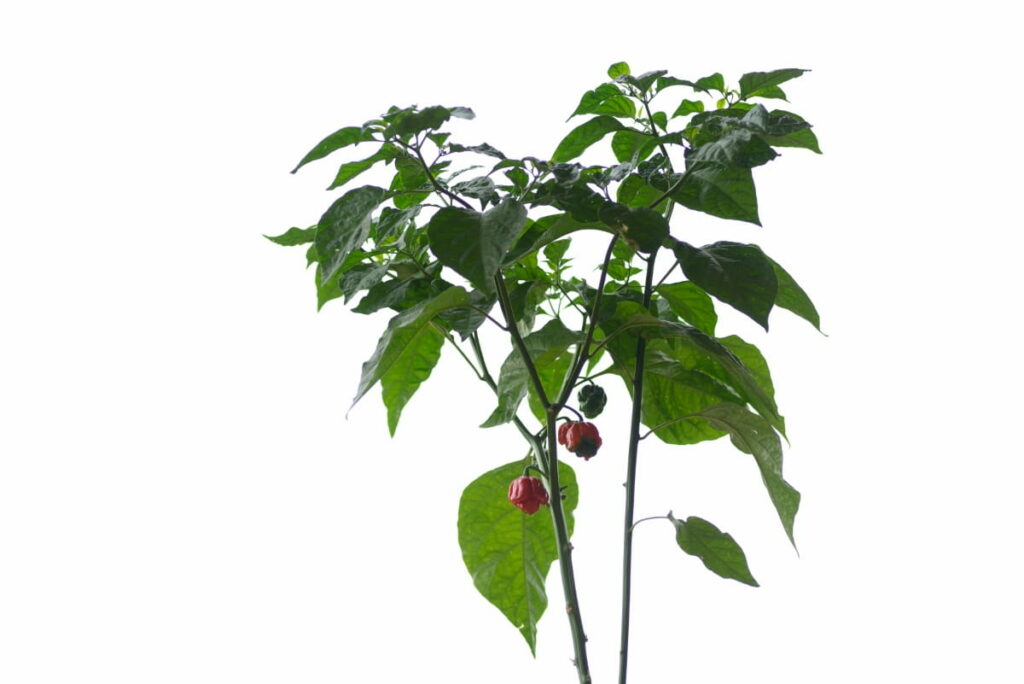
Soil Requirements for Growing Carolina Reaper Peppers
These fiery chilies thrive in well-draining soil that is rich in organic matter. A sandy loam soil with good fertility and pH levels between 6.0 and 6.8 is ideal for their growth. Before planting your Carolina Reaper seeds or transplants, prepare the soil by loosening it with a garden fork or tiller to improve its texture and allow for better root penetration. Incorporating compost into the soil will enhance its nutrient content and moisture-holding capacity.
To ensure optimal growth, ensure the soil remains consistently moist but not soggy. Overwatering the Pepper plant can lead to root rot, while underwatering can cause stress and hinder fruit development. Adding a mulch layer around your plants will help retain moisture, suppress weeds, and regulate temperature fluctuations in the soil. Organic mulch are excellent choices, like straw or wood chips.
Temperature and Climate Considerations for Growing Carolina Reaper Peppers
The Carolina Reaper, a tropical plant, requires warm temperatures to thrive. It prefers daytime temperatures between 21-32°C and nighttime temperatures not below 15°C. Frost is this fiery pepper’s enemy, so protect your plants if frost is expected. Regarding humidity levels, the Carolina Reaper enjoys a moderately humid environment. Aim for a humidity range of 50-70%. If you live in an area with high humidity, proper air circulation around the plants is crucial to prevent diseases caused by excessive moisture.
Sunlight plays an important role in the development of these spicy peppers. They need at least six hours of direct sunlight daily. Therefore, choose a location that receives plenty of sunshine throughout the day. You can enjoy an abundant harvest of these scorching hot chili peppers by providing the right temperature and climate conditions for your Carolina Reaper peppers.
Watering and Irrigation Techniques for Carolina Reaper Pepper Plants
Proper watering of the Pepper plant is essential for the healthy growth of Carolina Reaper pepper plants. These fiery chili peppers thrive in well-drained soil, so avoiding overwatering is important, which can lead to root rot. Instead, aim for deep but infrequent watering. During the hot summer, when the sun beats down relentlessly, keeping your Carolina Reaper plants hydrated is crucial.
In case you missed it: Black Pepper Cultivation Information Guide
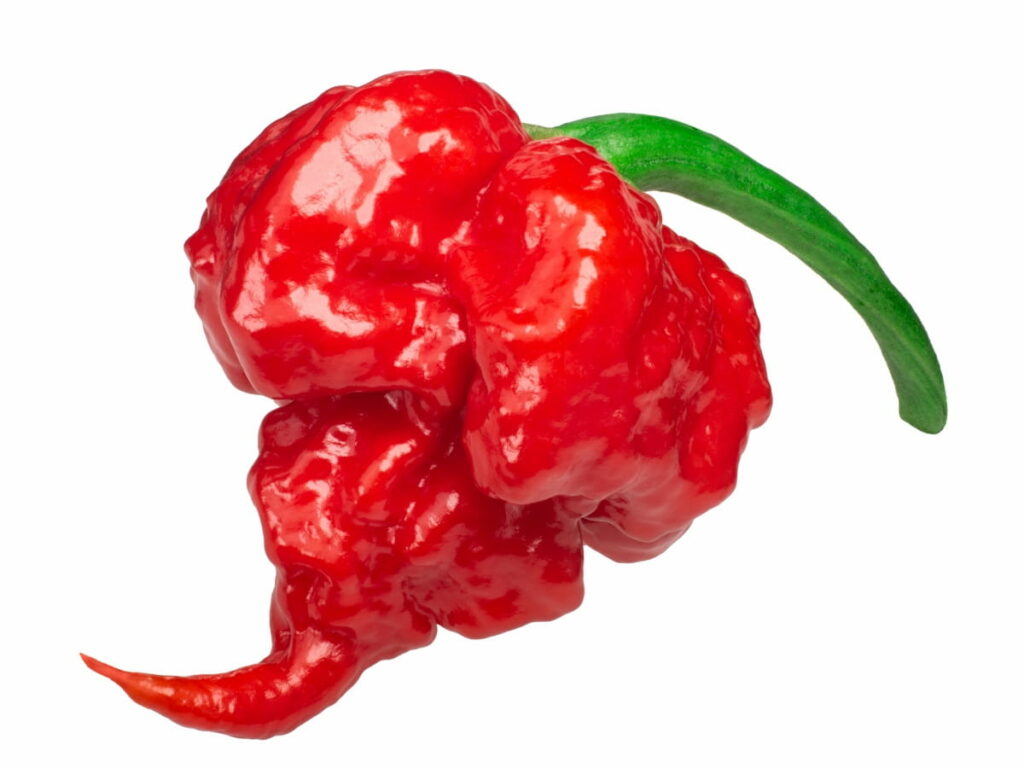
Water them deeply once or twice a week, depending on weather conditions. The goal is to saturate the soil around the roots without creating standing water. Remember that these spicy peppers originate from tropical regions and prefer warm temperatures. Avoid overhead watering, as wet foliage can promote fungal diseases. Instead, use drip irrigation or water directly at ground level with a hose or watering can. Keep an eye on your plants during heavy rainfall, as excessive moisture can lead to issues such as blossom end rot.
Fertilization and Nutrient Management for Healthy Carolina Reaper Plants
These fiery chili peppers require a balanced diet to thrive and produce their signature heat. When it comes to fertilizing Carolina Reapers, organic options are preferred. Using compost or well-decomposed manure can provide essential nutrients while improving soil structure. Additionally, incorporating bone meal or fish emulsion can supply the necessary phosphorus for strong root development.
Timing is key when fertilizing these pepper plants. Applying a balanced fertilizer high in nitrogen before transplanting will give them an initial boost. Regular plant health monitoring is crucial when managing nutrients for Carolina Reaper plants. Watch for nutrient deficiency signs, such as yellowing leaves or stunted growth, which may indicate adjustments need to be made.
Pruning and Training Techniques for Optimal Growth of Carolina Reaper Peppers
These practices help maintain the plant’s shape and promote better air circulation, sunlight exposure, and fruit production. When it comes to pruning, it is important to regularly remove any dead or damaged branches. This helps redirect energy toward healthier parts of the plant. Removing suckers (small shoots that emerge from the base) can also prevent overcrowding and improve airflow.
Training techniques like staking or trellising can support Carolina Reaper plants as they grow taller. This prevents them from bending or breaking under their weight. It also makes harvesting easier by keeping fruits off the ground. Remember always to use clean, sharp tools when pruning and be cautious not to damage healthy parts of the plant.
Common Pests and Diseases Affecting Carolina Reaper Pepper Plants
One common pest that affects Carolina Reaper peppers is aphids. These aphids suck the sap from the plant leaves, causing them to wilt and die. You can introduce beneficial insects or use organic insecticidal soap to combat aphids. Another pesky critter that loves feasting on Carolina Reapers is the tomato hornworm. These large green caterpillars can quickly defoliate your plants if left unchecked. Handpicking them off your plants or using Bacillus thuringiensis (Bt) is a natural way to control their population.
In case you missed it: Capsicum Cultivation (Bell Pepper) Information Guide
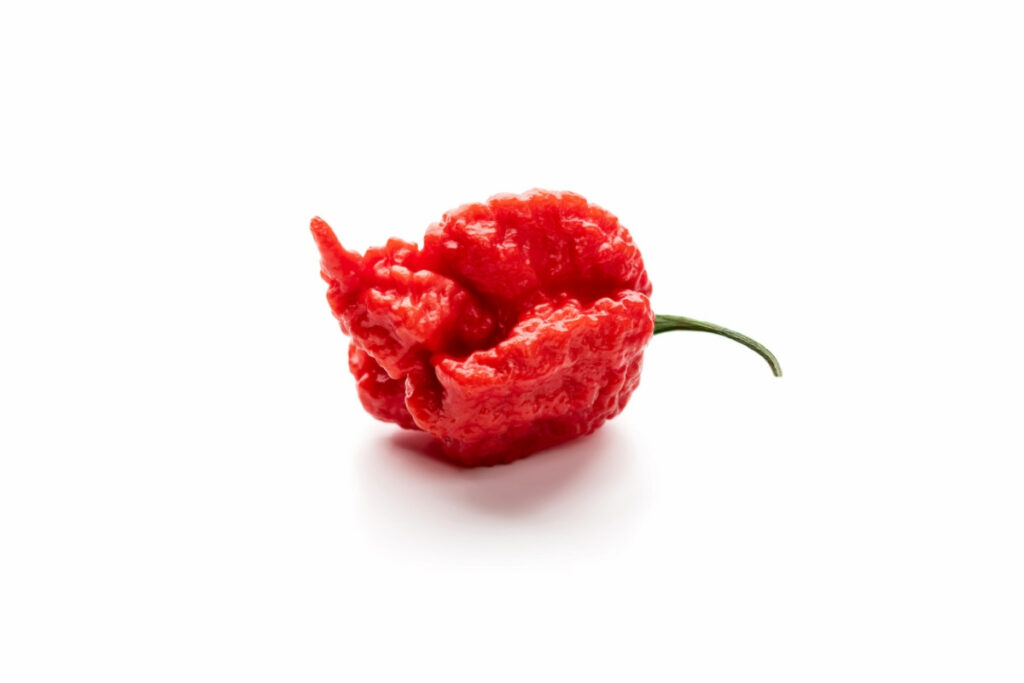
Fungal diseases are common issues for Carolina Reaper plants. Proper spacing between plants and good air circulation can help prevent these fungal infections. Regularly inspecting your plants, practicing proper sanitation techniques, and providing adequate care will go a long way in keeping these nuisances at bay. Remember, prevention is key to maintaining healthy Carolina Reaper pepper plants.
Harvesting and Storing Carolina Reaper Peppers: Best Practices
When it comes to harvesting Carolina Reaper Peppers, timing is crucial. Wait until the peppers have turned red, indicating full maturity. Gently twist or cut the pepper off the plant, carefully not damaging any nearby fruits. Once harvested, it’s important to handle Carolina Reaper peppers with caution due to their extreme heat. Wear gloves while working with them. After harvesting, immediately transfer the peppers to a cool, dry location for further processing.
To store Carolina Reaper peppers long-term, drying is often recommended. Hanging them in a well-ventilated area with good air circulation will help remove moisture and preserve their flavor and heat intensity. Alternatively, you can use a dehydrator set at low temperatures. If freezing is preferred over-drying, blanch the peppers by briefly immersing them in boiling water before transferring them into freezer bags or containers. This process helps retain their vibrant color and texture when thawed later on.
Culinary Uses of the Carolina Reaper Pepper in Spicy Recipes
This fiery chili is the world’s hottest pepper, adding an intense kick to any dish. The culinary uses of the Carolina Reaper are endless. You can incorporate this blazing hot pepper into salsas, hot sauces, marinades, and cocktails. Add minced Carolina Reapers to homemade chili or curry dishes for an extra punch of heat. But be warned – tread lightly unless you want smoke from your ears.
Safety Precautions when Handling and Consuming Carolina Reaper Peppers
This fiery chili can pack a punch like no other, so it’s important to take some safety precautions when handling and consuming these peppers. The Carolina Reaper is not for the faint of heart or weak taste buds. It packs a serious punch, so handle it carefully and wear gloves when cutting or handling the peppers. Always remember to wear gloves when handling Carolina Reapers. The capsaicin in these peppers can cause intense burning in your skin.
Another tip is to avoid touching your face or any sensitive areas after handling the peppers. Capsaicin residue on your hands can easily transfer and cause discomfort or harm. If you’re planning on cooking with Carolina Reapers, make sure to work in a well-ventilated area. And, of course, never underestimate the heat of the Carolina Reaper. Start slow and gradually increase the amount used in recipes until you find your tolerance level. Remember, it’s always better to err on caution than regretting it later.
Carolina Reaper Pepper Vs Ghost Pepper
The Carolina Reaper boasts an average SHU rating higher than its ghostly counterpart’s, reaching an impressive peak of 2.2 million SHU. In comparison, the Ghost Pepper typically averages around 1 million SHU. Not only do these peppers differ in spiciness but also in appearance. The Carolina Reaper stands out with its compact and gnarled texture resembling a scorpion’s shape, complete with a distinctive tail. On the other hand, Ghost Peppers have an elongated and wrinkled appearance, which sets them apart from their scorching rival.
In case you missed it: Best Fertilizer for Curry Leaves in Pots: Organic, Natural, Homemade, NPK, When and How to Apply
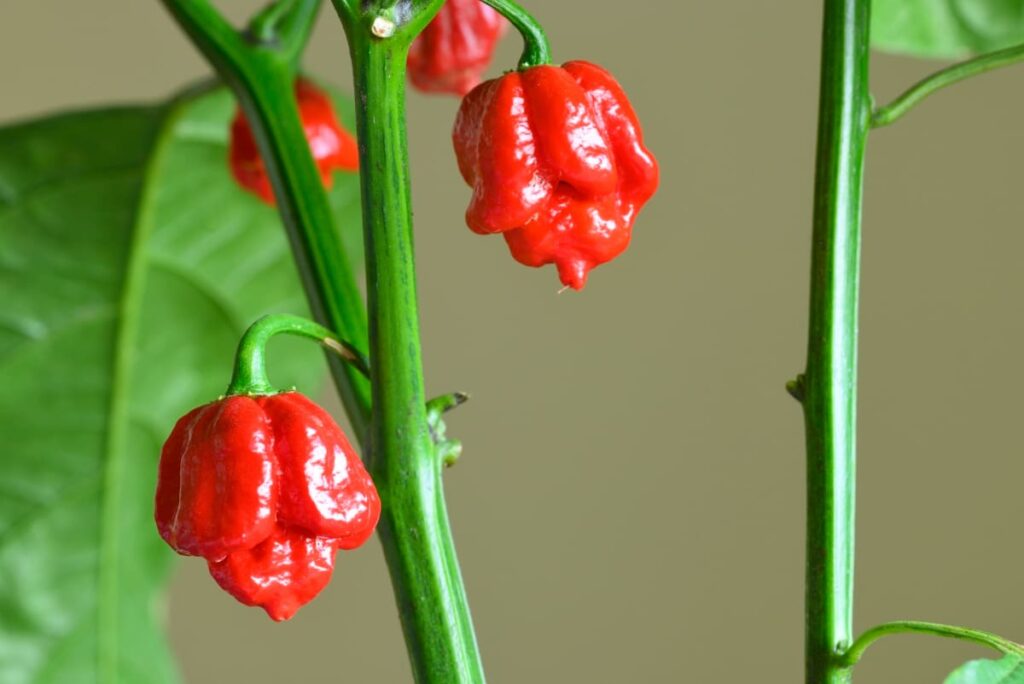
Carolina Reaper Pepper Vs. Scorpion Pepper
When it comes to heat, the Carolina Reaper Pepper takes the crown. With a scorching 2.2 million SHU (Scoville Heat Units), this pepper is not for the faint of heart. In comparison, most Scorpion pepper varieties range from 1.2-1.6 million SHU, making them no slouch in terms of spiciness.
The Carolina Reaper has a gnarled and bumpy texture that sets it apart from other peppers. Its small pointed tail adds to its distinctive look and gives it an extra touch of character. On the other hand, Scorpion peppers are smaller and wrinkled, with some resembling a scorpion stinger tail.
Carolina Reaper Pepper Price
The price of Carolina Reaper peppers can vary depending on where you purchase them. At a regular price of $35.00, Carolina Reaper peppers are known as the hottest peppers in the world. Some specialty stores or online retailers may charge around $20 for just a few fresh peppers. However, if you’re willing to put in the time and effort, growing your own Carolina Reapers from seeds is a more cost-effective option. Carolina Reaper seeds are available online at prices ranging from $2 to $5 per seed packet.
Conclusion
The Carolina Reaper has a surprisingly sweet and fruity flavor hiding beneath that intense spiciness. It adds depth and complexity to dishes that any other pepper can’t replicate. How long does it take to grow a Carolina Reaper? From planting seeds to harvest time takes approximately 90 days after transplanting into nutrient-rich soil. You’ll soon be rewarded with a bountiful harvest with proper care and attention to watering, temperature control, and pruning techniques.
- How to Raise Pigs in Your Own Backyard: A Comprehensive Guide
- Budget Friendly Sheep Shed Ideas: Cheap and Low-Cost Tips
- How Much Do Cattle Farmers Make: Revenue Streams in Cattle Farming
- Management Pests and Diseases in Your Cotton Field
- Sheep Farming Business Plan for Beginners
- Aquaponic Farming at Home: A Step-By-Step Guide
- Profitable Village Farming Business Ideas in 2024
- High-Yield Aquaculture: Fast-Growing Fish for Farming
- Effective Fish Pond Construction Techniques for Beginners
- Irrigation and Water Management in Pineapple Farming
- Blossom to Harvest: Mastering Flowering and Pollination in Papaya Farming
- Pig Fattening Essentials: From Selection to Sale for Beginners
- Raising Wagyu Cattle: A Complete Guide for Premium Beef Production
- Soil Types and Their Water Holding Capacity
- Optimizing Irrigation Schedules for Coconut Groves for Enhanced Yield
- Espresso Your Garden: Coffee Grounds for Healthier Acid-Loving Plants
- The Best Soil Mix for Snake Plants: How to Mix Your Own Snake Plant Soil
- Green Thumb Success: Expert Tips for Cultivating Greenhouse Beans All Year Round
- Bloom All Year Round: The Ultimate Guide to Indoor Hyacinth Care
- Eco-Friendly Gardening: How to Make Liquid Fertilizer from Kitchen Waste
- Ultimate Guide to Grow Anise in Pots: Explore Seed Propagation to Harvesting
- Guide to Raising Chester White Pigs: Discover Breed Facts to Growth Management
- Mastering the Elegance: The Ultimate Guide to Weeping Cherry Tree Care, Planting, and Maintenance
- Ultimate Guide to Planting Garlic in Grow Bags: Growing Strategies for Beginners
- How to Fix Spider Plant Leaf-Related Problems: Natural and Organic Remedies
- 10 Reasons Why Your Tulsi Plant is Shedding Leaves: Home Remedies and Solutions
- Optimizing Growth and Yield: The Advantages of Palm Bunch Ash Fertilizer
- Utilizing Neem Oil Extract as a Natural Pesticide for Hydrangea
- From Soil to Harvest: Various Ways in Which Farmers Can Use AI Tools
- Steps to Encourage and Induce Citrus Flowers: A Comprehensive Guide
- How to Fix Snake Plant Leaf-Related Issues: Natural and Organic Remedies
- Transform Your Garden into a Fragrant Oasis with Raat Ki Rani (Night Blooming Jasmine)
- Discover the Ideal Chicken Breeds for Philippine Farms
- How to Create a Poultry Egg Farm Business Plan for Profits
- Grow Lemon Cucumbers Like a Pro: Insider Techniques for Bountiful Yields
- Ultimate Guide to Caring for Your Pink Princess Philodendron: Tips for Thriving Variegation
